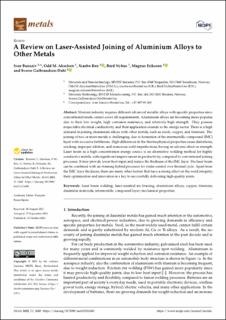| dc.contributor.author | Bunaziv, Ivan | |
| dc.contributor.author | Akselsen, Odd Magne | |
| dc.contributor.author | Ren, Xiaobo | |
| dc.contributor.author | Nyhus, Bård | |
| dc.contributor.author | Eriksson, Magnus Carl Fredrik | |
| dc.contributor.author | Gulbrandsen-Dahl, Sverre | |
| dc.date.accessioned | 2022-08-26T11:18:19Z | |
| dc.date.available | 2022-08-26T11:18:19Z | |
| dc.date.created | 2021-10-28T11:58:01Z | |
| dc.date.issued | 2021 | |
| dc.identifier.citation | Metals. 2021, 11 (11), 1680. | en_US |
| dc.identifier.issn | 2075-4701 | |
| dc.identifier.uri | https://hdl.handle.net/11250/3013768 | |
| dc.description.abstract | Modern industry requires different advanced metallic alloys with specific properties since conventional steels cannot cover all requirements. Aluminium alloys are becoming more popular, due to their low weight, high corrosion resistance, and relatively high strength. They possess respectable electrical conductivity, and their application extends to the energy sector. There is a high demand in joining aluminium alloys with other metals, such as steels, copper, and titanium. The joining of two or more metals is challenging, due to formation of the intermetallic compound (IMC) layer with excessive brittleness. High differences in the thermophysical properties cause distortions, cracking, improper dilution, and numerous weld imperfections, having an adverse effect on strength. Laser beam as a high concentration energy source is an alternative welding method for highly conductive metals, with significant improvement in productivity, compared to conventional joining processes. It may provide lower heat input and reduce the thickness of the IMC layer. The laser beam can be combined with arc-forming hybrid processes for wider control over thermal cycle. Apart from the IMC layer thickness, there are many other factors that have a strong effect on the weld integrity; their optimisation and innovation is a key to successfully delivering high-quality joints. | en_US |
| dc.language.iso | eng | en_US |
| dc.publisher | MDPI | en_US |
| dc.rights | Navngivelse 4.0 Internasjonal | * |
| dc.rights.uri | http://creativecommons.org/licenses/by/4.0/deed.no | * |
| dc.subject | Laser beam welding | en_US |
| dc.subject | Laser-assisted arc brazing | en_US |
| dc.subject | Aluminium alloys | en_US |
| dc.subject | Copper | en_US |
| dc.subject | Titanium | en_US |
| dc.subject | Dissimilar materials | en_US |
| dc.subject | Intermetallic compound layer | en_US |
| dc.subject | Mechanical properties | en_US |
| dc.title | A Review on Laser-Assisted Joining of Aluminium Alloys to Other Metals | en_US |
| dc.type | Peer reviewed | en_US |
| dc.type | Journal article | en_US |
| dc.description.version | publishedVersion | en_US |
| dc.rights.holder | © 2021 by the authors | en_US |
| dc.source.volume | 11 | en_US |
| dc.source.journal | Metals | en_US |
| dc.source.issue | 11 | en_US |
| dc.identifier.doi | 10.3390/met11111680 | |
| dc.identifier.cristin | 1949229 | |
| dc.relation.project | Norges forskningsråd: 237900 | en_US |
| dc.source.articlenumber | 1680 | en_US |
| cristin.ispublished | true | |
| cristin.fulltext | original | |
| cristin.qualitycode | 1 | |

